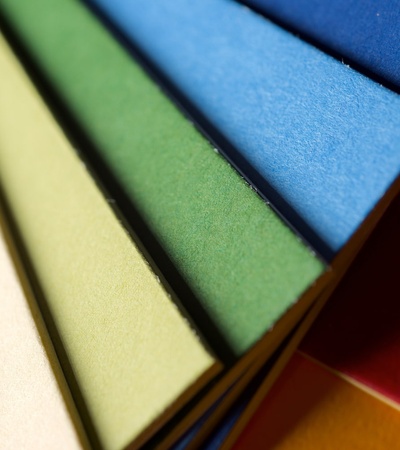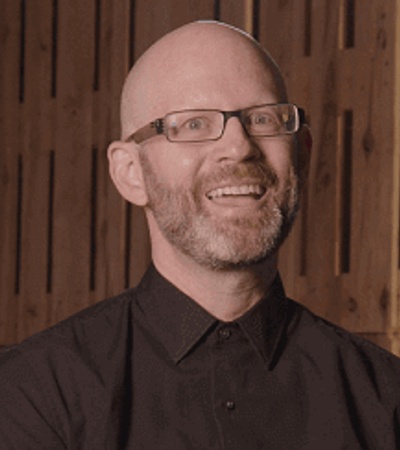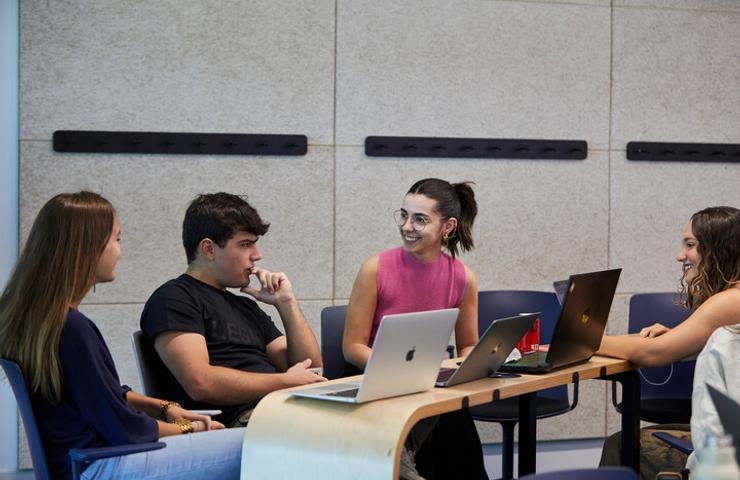
- Home
- Studies
- Undergraduate Degrees
- Bachelor In Design: Interior Design Track
AN INNOVATIVE BACHELOR IN DESIGN: INTERIOR DESIGN TRACK
The Bachelor in Design: Interior Design track at IE University is not like traditional design degrees. It’s an innovative program that combines our celebrated academic rigor, the vast, sector-specific expertise of our faculty, and strong professional partnerships. And its curriculum is tailored to cultivate the talents of aspiring interior designers, preparing them to create transformative and functional spaces.
Our study plan provides passionate students with the essential skills and insights needed to succeed in the interior design industry. Through our hands-on teaching methodology, students experience a blend of theoretical learning and practical application, engaging with real-world interior design projects.
This forward-thinking approach ensures that our graduates are not only proficient in current design practices but also ready to pioneer and adapt to new trends and technologies of the 21st century. By the program's end, students will be equipped to enhance physical environments and elevate the human experience through exceptional interior design.

BACHELOR IN DESIGN STUDY PLAN: INTERIOR DESIGN TRACK
LEARN MORE ABOUT OUR BACHELOR IN DESIGN: INTERIOR DESIGN TRACK
FIRST YEAR
In your first year of The Bachelor in Design: Interior Design track, you will embark on a foundational journey exploring core principles of design. You'll engage in rigorous coursework that spans across various design disciplines, establishing a solid understanding of the discipline’s fundamentals and methodologies. The curriculum includes intensive studies in Projective Geometry, which will lay the groundwork for your spatial comprehension, and Principles of Interior Design, providing insights into aesthetic principles and spatial functionality essential for successful interior designers.
SECOND YEAR
Building upon your foundational knowledge, the second year emphasizes deeper exploration into specialized areas within interior design. You will participate in Core Bachelor inDesign: Interior Design track coursework tailored to hone your design skills across disciplines. You'll delve into the intricacies of sustainable design through the Sustainable Materials Workshop, gaining insights into eco-friendly practices and materials selection—crucial for sustainable interior solutions. Additionally, you will explore Scenography and Exhibition Design, focusing on creating immersive spatial experiences that integrate design aesthetics with functional requirements.
THIRD YEAR
Your third year takes you deeper into specialization, exploring advanced interior design concepts and practices. You will engage in Design Studio projects centered on creating functional and innovative spaces for everyday life and collaborative environments. You'll delve into Digital Transformation in Interior Design, exploring the integration of technology into spatial design solutions. Sustainable Interior Design Strategies will equip you with the knowledge to implement environmentally conscious practices, while courses in Lighting, Acoustics and Surfaces will deepen your understanding of design’s sensory aspects. The Business of Interior Design course, meanwhile, introduces the strategic thinking and management skills essential for your professional success in the field.
FOURTH YEAR
In your final year, you will synthesize your learning and apply it to real-world projects through our advanced Design Studio: Shared Spaces. This culminating experience will allow you to demonstrate your expertise in creating comprehensive interior design solutions that meet both aesthetic and functional requirements. The Final Project will serve as a capstone, where you will showcase your innovative approaches and problem-solving skills, preparing you for professional practice. Core Bachelor in Design: Comprehensive Design coursework continues to provide you with a broad perspective on design principles, ensuring you are well-rounded and equipped to embark on impactful careers in interior design.
WATCH THIS SUSTAINABLE ARCHITECTURE & DESIGN MASTERCLASS
Join David Goodman's masterclass on green building, learning stylish, eco-friendly design from top architects. Create loved, sustainable spaces. Design with the planet in mind!

Learning a new language can open up a world of new opportunities
IE University considers multiple language acquisition to be a key element of its educational model, leading to success in both work and study.
The Language Center at IEU is proud to offer students the possibility to study a wide range of languages, including French, German, Portuguese, Chinese, Arabic, Spanish, and English. With such a large variety of options, our students are able to personalize their academic path to meet their future career plans and objectives.

The Language Center at IEU
The Language Center helps students develop their multilingual communicative skills to help them flourish in the international labor market.
COMPETENCES
Basic competences
GENERAL COMPETENCES
- Develop a basic ability to spell out relevant outcomes through practical application in different fields of design, incorporating information from other disciplines.
- Understand design’s impact and implications for contemporary society and be capable of offering solutions and actively participating in creation and conceptualization processes.
- Suggest and implement proposals involving creative activities to provide added value to the everyday activities of companies and society.
- Understand and use graphic language and tools to present, simulate and resolve design problems.
- Produce relevant outcomes as a result of hands-on involvement in different fields of design, including products, graphics or interfaces, and incorporating information from other disciplines, in order to develop new offerings and solutions and convey and pass on the knowledge acquired.
- Apply knowledge of modeling, visualization, materials technology and production techniques when conducting design projects, paying attention to their viability and social, technological and environmental constraints.
PROGRAM-SPECIFIC COMPETENCES
- Devise, plan and conduct design projects in line with requirements and the technical, functional, aesthetic and communication constraints of a brief.
- Develop the ability to create designs that simultaneously meet aesthetic, theoretical and technical requirements.
- Understand and interpret historical, theoretical and critical texts in the fields of design, art and architecture in a relevant and logical manner.
- Learn relevant methods to apply the creative process to professional situations and innovative problem-solving.
- Interpret and critically evaluate final products and design projects created by yourself and others.
- Learn relevant research methods used in project design and theory, analysis and criticism in the fields of design and art.
- Graphically structure and prioritize verbal information.
- Present and explain the outcomes and work processes used to obtain objects you have designed, both orally and in writing.
- Learn and master the graphic elements used in design and visual communication and the tools used to create and produce them, using a variety of physical, audiovisual or digital means.
- Implement strategies and methodologies to obtain innovative solutions to creative briefs. Acquire basic knowledge of information presentation and visualization techniques.
- Use basic digital expression techniques (programming, interaction and multimedia resources) in order to conduct design projects.
- Use digital tools to bring communicative and expressive actions in line with their intended use through design solutions.
- Understand industrial and artisanal manufacturing processes as well as their main features and limitations.
- Recognize the ways in which digital manufacturing can contribute to design, as well as its main features and limitations.
- Master the aesthetic fundamentals of design, including morphology, structure, color, space, volume, tectonics, typography and composition.
- Master the fundamentals of typography, mockup and presentation techniques.
- Apply basic social science knowledge to design projects, including elements from psychology, analytical fields, sociology, programming, ethnography, social science research methods, etc.
- Understand how to apply social science statistics and analytical tools to design projects.
- Propose research and innovation strategies with the aim of meeting the functionality, needs and materials expectations of design.
- Recognize and make use of the advantages offered by programming when it is used as a design tool.
- Add technology and digital manufacturing to the list of tools available to you to solve problems related to proposed design statements.
- Understand the materials and materialities used as a medium for both physical and digital visual design.
- Understand the media and materialities that make product design possible, both for physical and digital products.
- Understand the materials and materialities that define spatial design.
- Understand the structures used to define a strategic design project.
TRANSVERSAL COMPETENCES
- Identify the main cultural identity traits that characterize today’s world by understanding the main contemporary ideological trends.
- Behave professionally in accordance with the core principles and ethics of the profession.
- Manage unforeseen situations by being able to adapt to organizational changes.
- Use knowledge of the discipline to analyze and evaluate current situations.
- Form a part of interdisciplinary and multicultural teams to achieve shared goals in a diverse environment.
- Work actively in an international context.
APPLICABLE REGULATIONS OF THE PROGRAM
FREQUENTLY ASKED QUESTIONS
Do you have to be good at art to be an interior designer?
While having a talent for art can be beneficial, interior design schooling focuses on developing your design skills, creativity, and technical knowledge. You don't have to be a skilled artist to start an interior design degree.
How many years is The Bachelor in Design: Interior Design track?
A typical bachelor's degree in design usually takes four years to complete, depending on the design school and the specific program.
What is the highest degree in interior design?
The highest degree in interior design is typically a master's degree, such as a Master of Interior Design or a Master of Fine Arts in Interior Design.
Which degree is best for interior design?
A Bachelor in Design: Interior Design track or a Bachelor of Arts in Interior Design is considered the best degree for aspiring interior designers.



